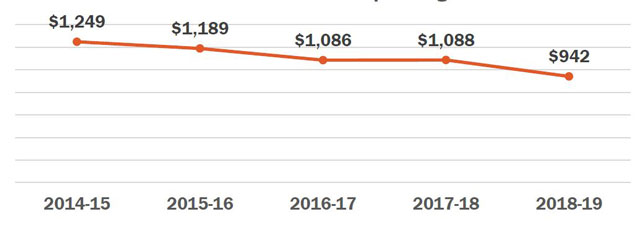Report: Student Spending on College Course Materials in Decline
- By Dian Schaffhauser
- 07/24/19

Combined spending on course materials, tech and school supplies. Source: "Student Watch Attitudes and Behaviors toward Course Materials: 2018-2019 Report," National Association of College Stores
For the first time in a long time, combined spending over the academic year on course materials, technology and school supplies came in under $1,000, according to a recent survey by the National Association of College Stores (NACS). And students spent less on course materials than in years past — 14 percent less than a year ago and 40 percent less than 11 years ago. Outlay for technology also shrank, from about $473 last year to $419 in the latest year, a 13 percent decrease. Students spent an average of $415 on required curriculum (an average of $45 per item) and another $527 on tech and supplies.
The survey was conducted across 41 institutions in both the United States and Canada and included responses from 20,000 students.
A big majority of students (89 percent) also said they've used some type of free content. Free content included class handouts, lecture notes, website articles, academic journals or textbooks, all of which might be borrowed, shared, handed out by faculty or downloaded. In spring 2019, a fifth of students (22 percent) reported downloading free content, a doubling of the number who said the same three years earlier, in spring 2016.
The campus store remained the top source for acquiring course materials. For the latest year, 79 percent of students said that's where they turned. While six in 10 (57 percent) purchased from the store in person, 46 percent also said they handled the transaction through the bookstore website. Amazon was popular, mentioned by 46 percent of students, compared to 18 percent who said they headed to the publisher website and 10 percent who said they visited Chegg.
Most students reported that they still prefer to purchase course curriculum over other acquisition options. Eighty-six percent said they purchased course materials in spring 2019, compared to 14 percent who said they rented it. The cost between those two options differed by a factor of six: Nearly $170 was spent during a purchase and $28 was spent during a rental. According the survey project, the share of students choosing to purchase materials hasn't changed much over the last four semesters.
A partiality for used print books exceeded new when students purchased (40 percent versus 39 percent). The share of used print books for rentals was considerably higher — 70 percent — compared to new (which was 14 percent).
Students still preferred print over digital content, a choice in slow erosion. While 26 percent in 2019 said they "strictly" prefer a printed textbook, that was down 6 percent from fall 2012, when they were asked the question for the first time.
A second preference was print with a digital component, such as online access to additional content. While 21 percent said they preferred this format combination in the latest survey, the overall share was down slightly from 2014.
A third of students (36 percent) admitted that they came to class on day one without any materials. They didn't wait because of cost, the survey found, but because they wanted to find out how necessary the course materials were really going to be before they invested in them. Another compelling driver: They didn't know what was required.
One in five respondents said they'd participated in "inclusive access" programs, a model in which the institution makes sure every student has the same materials on the first day of class, and nearly half (49 percent) expressed satisfaction with that approach; another 23 percent said they were dissatisfied.
The annual "Student Watch Attitudes and Behaviors toward Course Materials: 2018-2019 Report" was funded by the NACS Foundation and developed by OnCampus Research, the research arm of NACS.
A complete copy of the research findings is available for purchase from NACS.
About the Author
Dian Schaffhauser is a former senior contributing editor for 1105 Media's education publications THE Journal, Campus Technology and Spaces4Learning.